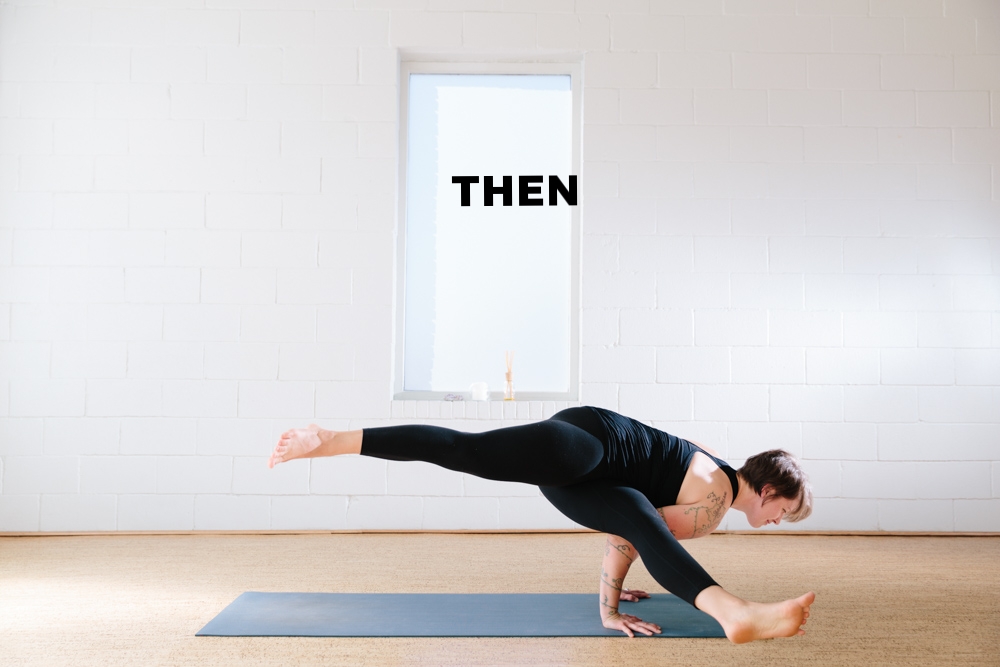Flexibility is a fascinating concept to me. It is often placed on a pedestal as thought it is the holy grail of yoga, and thus yoga teachers are frequently engaged in conversations about flexibility, resulting in some fun flexibility-themed memes, like the ever-popular Batman-slapping-Robin:
Or the plethora of “me vs. everyone else” funnies:
In the context of most conversations where yoga and flexibility intersect, physical flexibility is the topic. But as I am committed to speaking honestly about what yoga does and what it does not do, I have to say that practicing yoga a couple of times a week is not necessarily going to lead to a profound increase in flexibility. Why? Because flexibility is largely a function of someone’s anatomy — connective tissue type and joint structure. The increases in mobility we see and call flexibility are really ways the brain and body adapt to altered movement demands within the limits of our anatomy. And these adaptations can look and, more importantly, feel incredible, don’t get me wrong, but they are not due to some intrinsic shift in flexibility.
To me this is important to say, because somehow as a culture, we have come to believe that the external achievement of a person able to do the splits or urdhva dhanurasana (“full wheel”) or touch their foot to their head is somehow better off in life. And yoga is so often sold as a results-oriented endeavor — look at me then versus me now!
I’m not picking on this person or diminishing the fascinating shift resulting from a consistent practice that resulted in the strength, balance, and mobility to achieve the shape. But images like these insinuate that one version of this posture is somehow better or more desirable than the others. and I think that mindset can be harmful. What’s more, this image tells me nothing about the human inside this shape. Yes, there is something inherently impressive about a beautiful shape and a physical feat, but I’m more interested in the internal results of dedication and commitment to a practice. I wonder if the effort was all about taking this comparison photo, or could this physical manifestation of shape change be a metaphor for a different kind of flexibility.
I would submit that the flexibility that makes life better is the kind you can’t see in a photo. What if the “then vs. now” photos looked something like this?
Or this?
Is one version better? Or are they just different variations that serve different purposes at different times? Is asana just the act of creating shapes for the sake of proving we can create shapes, or is it a vehicle to something else?
These days, I’m way more interested in the ways yoga helps me become mentally and emotionally flexible so that I can move through life in such a way that my negative emotions inform me instead of overwhelm me. I want the mental flexibility to recognize when my thoughts and behaviors reflect patterns that don’t serve me so that I can disrupt those patterns. As a very empathetic person, I want the emotional flexibility to be able to see and respond compassionately to the emotional needs of others without taking on other people’s shit. And when I practice asana, I want the flexibility to let go of what I think poses “should” look like so that I can freely and creatively explore how poses can fit my body, not the other way around.
Do I still love to practice yoga-gymnastics-type poses? You bet I do! Expanding the horizons of what I believe I am capable of has been a valuable part of my yoga practice. But I also know that I must constantly check in with my “why?” in instances of great physical challenge. Am I practicing in a way that is largely safe and serving a purpose, or am I practicing this way because the teacher said to and other people around me are doing it and I want external validation? Let me tell you, sometimes the answer is external validation. And that’s where I need the flexibility to recognize that truth and change something. I have already spent plenty of energy in my life worrying that I am not the doing the right thing, or enough things, or doing things the right way. Ugh. Why would I want to reinforce those mental habits when I practice yoga?
Aside from a mental or emotional personal journey, I actually think the concept of flexibility needs to be applied more and more to the present yoga industry culture so that we can move away from exclusionary images and practices, and so that yoga can feel inviting rather than intimidating.
Is one pose better than another? Is one type of alignment better than another? Doesn’t it depend on who is practicing, at what time, and for what purpose? Experience has shown me that progress is not actually a linear concept. Progress has to take into account new or shifting status, new or shifting perspective, and new or shifting motivations.
My hope is that we can let go of the binary determinations like good and bad, right and wrong when it comes to practice, and that we can let go of rigid, linear definitions of progress, instead embracing “flexibility.” What would it look like and feel like if we took this broader definition of flexibility off the mat, both for ourselves and for our expectations of others?









